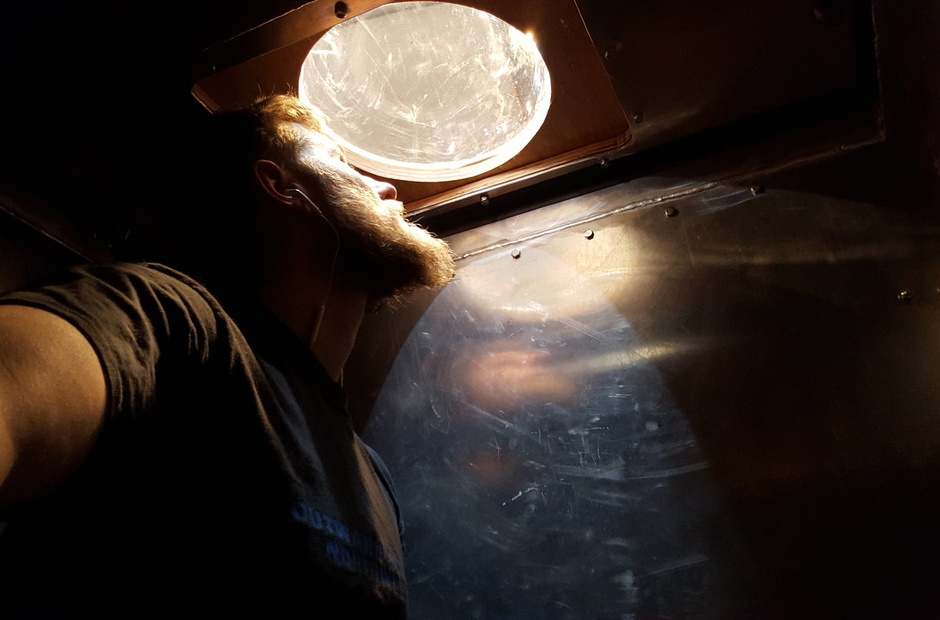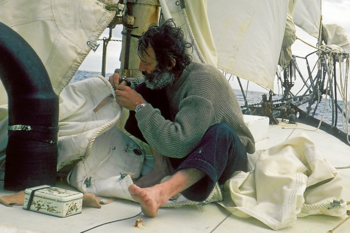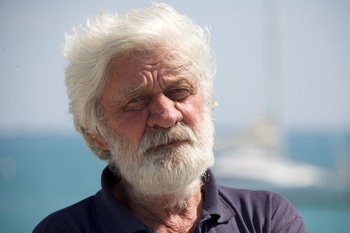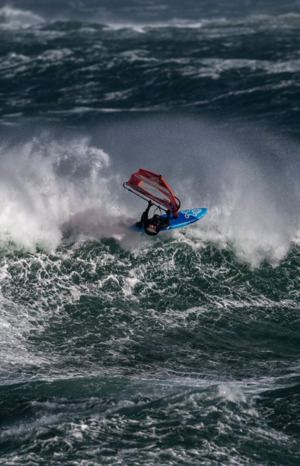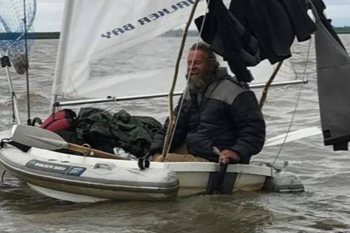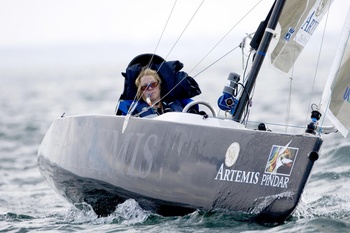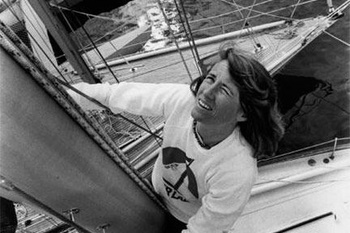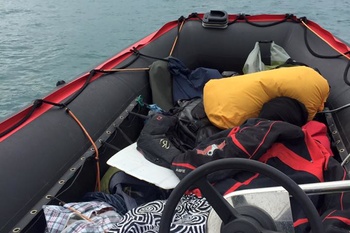Matt Kent worked on the big 200-foot Niagara sailboat. One day he was so tired of scrubbing square meters of floor, climbing tall masts and mending sails with a total area of two basketball courts, that he began to wonder: can you cross oceans on a yacht of very modest size?
Robert Manry crossed the Atlantic in 1968 on the 4.1 meter Tinkerbelle. Wilen Hugo broke this record in 1993 by squeezing himself into a 162 cm long Father's Day yacht. He spent 106 days in the ocean on it. This record remains undefeated to this day. In 2002 Tom McNally tried to cross the Atlantic on the 90 cm Vera Hugh II but failed.
Reading stories about other people's experiences, Matt Kent caught fire with the idea of building the smallest yacht that is basically possible to make transatlantic, and thus set an absolute record that cannot be beaten. In 2012, he began developing the project for a yacht called «Undaunted» («Fearless»).
Undaunted specifications
Length: 106 cm
Sedimentation: 1.5 m
Weight: 544 kilos.
Curb weight: 816 kg
Speed: 2.5 knots.
The sail area is 4.6 m2 (rectangular) and 2.5 m2 (triangular).
Little and Fearless
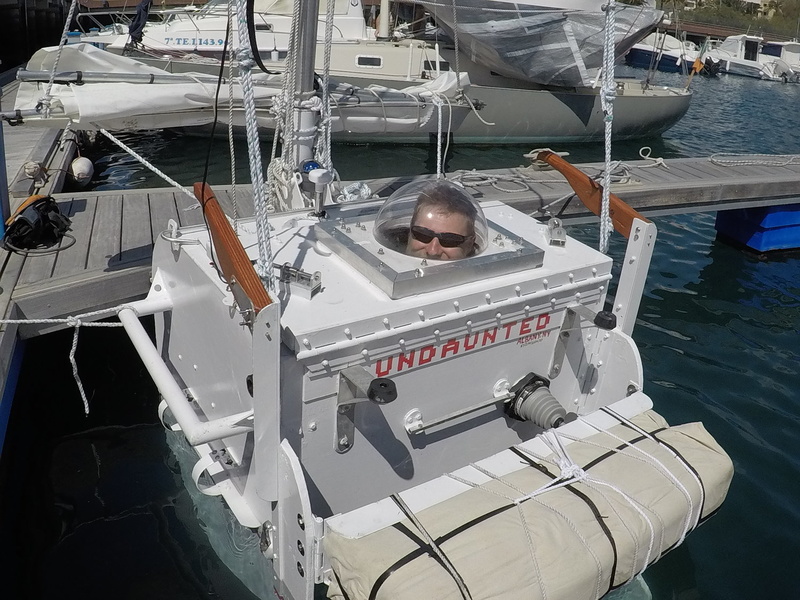
«Undaunted» is a 42-inch box-like yacht with a side height of 5 feet and lead ballast of 317 kg.
If the yacht had heeled aboard, she would have barely moved forward in the wind. That's why «Fearless» is designed so that under the pressure of the sail he rolls to his nose (it's called tangent) and quietly walks forward without unnecessary jolting.
The mini yacht's expected speed is 2.5 knots, so to improve controllability at low speeds and help the keel fight rocking, there are two massive rudder pens on the yacht. The rumpel is brought inside the cabin. No autopilot is provided on board.
The keel has a 40-gallon (151 litre) drinking water tank divided into four 10-gallon compartments. As the bays are emptied, the tank will be filled with intake water, which in this case acts as ballast and is necessary to maintain stability. The bottom has a 105 Ah battery, a mechanical generator and two manual desalters.
«Fearless» doesn't have an engine, so desalting water and charging batteries will be more difficult using foot pumps and a solar panel.
«There is initially a month's supply of fresh water on board. If the desalters fail, or if I'm injured, I can't run the pump and get fresh water or charge the batteries, it could be a serious problem»," says Matt Kent.
In order not to carry a life raft on board, «Fearless» has a buoyancy system - cylinders mounted around the hull and filled with carbon dioxide. Each cylinder can support the weight of the boat and all three lift the boat to the surface even if it is filled with water. The CO2 on board is enough to keep the yacht afloat three times.

«The rafting company has made several cylinders to ensure buoyancy. If I get flooded or get punctured, I can turn the valve inside the yacht to fill the CO2 tanks and the yacht will stay afloat until I patch her up and drain the water»," Matt explains.
There are two 16-gallon polyethylene tanks tied up on both sides that look like pack bags. They contain lightweight items such as clothing and extra tie ends.
«In the event of flooding, that's an extra margin of buoyancy»," Matt said.
There are two hatches above. The smaller one is fixed to the larger one.

The larger one opens into the stern to form a worktable and prevents water from flooding from the stern. The smaller one has a viewing dome sized to allow Matt to fit into it:
«The hatch I'm standing in is a little above the waist. This is so I don't fall overboard when crossing - although I will always be double insured».
First tests.
The first trials «Fearless was» held on Lake Erie from 23-26 October 2016. The weather forecast promised a good opportunity to go one way with the following wind and return the next day, but alas, it did not come true. Throughout the day, the wind intensified from full calm to 20 knots, constantly changing directions. Matt had to make short «runs»; at some point, he even ran aground.
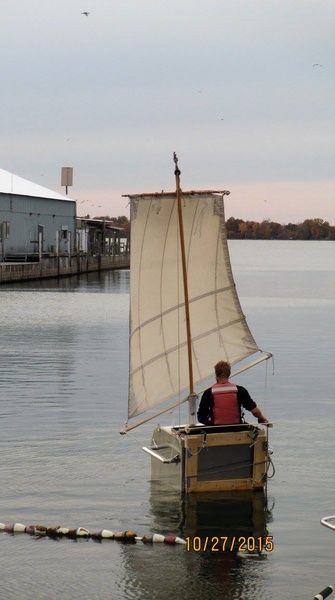
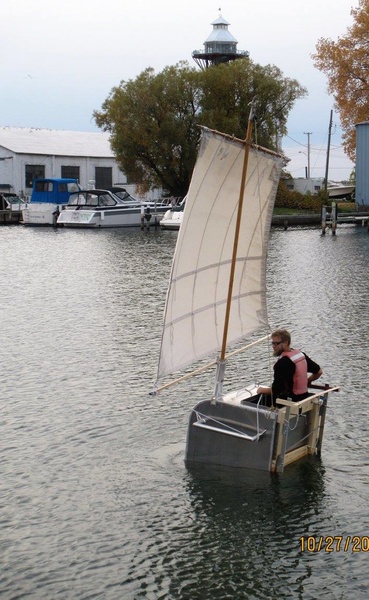
The trials, though they didn't go well, were an invaluable experience for Matt.
He made sure the yacht was moving confidently forward, pulling herself out in the wind because the mast is always tilted to the bow:
«The fearless one goes forward like a champion! The speed is small, but he holds»her steady.
Neither a wave from the lake nor two reflections from the breakwaters prevented the «Fearless»: the yacht simply rose and fell on the water.
The longitudinal centre of gravity of the keel is about 16 inches above it. With a side height of 5 feet, this stability will make any designer envious.
«We couldn't make Fearless any faster, we couldn't make it longer because of the record, so we decided to focus on security»," Matt said.
Living in an enclosed space.
«Going on "Fearless" sailing is quite easy, but life is harder. The seats inside are very close together»," Matt said.
You can only sit upright and lean back to relax, only diagonally.

The yacht is painted white so that the hull does not turn into a fryer and the entire surface board is isolated.
«The undersea hull is insulated so that the conductive properties of aluminum keep the interior»cool," explains Matt.
Given the limited space on board, the mast also serves as a ventilation duct and carries an AIS antenna, navigation lights and radar reflector. If the vent needs to be retracted, there is a neoprene mask with two non-return valves inside. One vents the air in and the other exhales carbon dioxide into the mast, i.e. out. That way, no condensation is formed inside.
In January 2017, Matt hung a Pelican case on the port side of the boat. Refinement seems insignificant, but with this size of space, every inch is important.
«If a thing doesn't perform at least three functions, it has to be reworked»," he said.
The case serves as a navigation table, a main table in the cabin, a communication point, an entertainment area, a storage box for tools and equipment, including a solar panel.
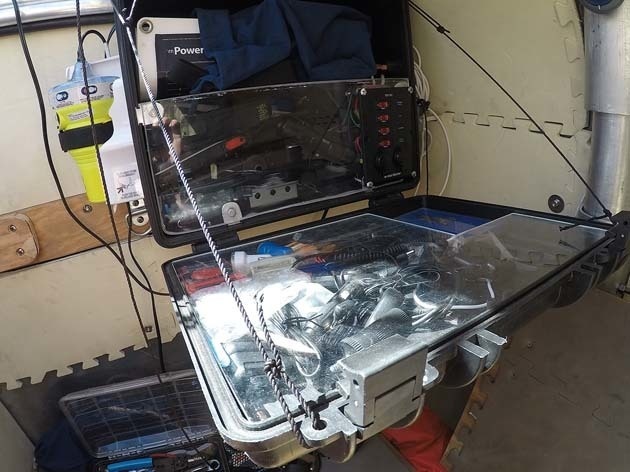
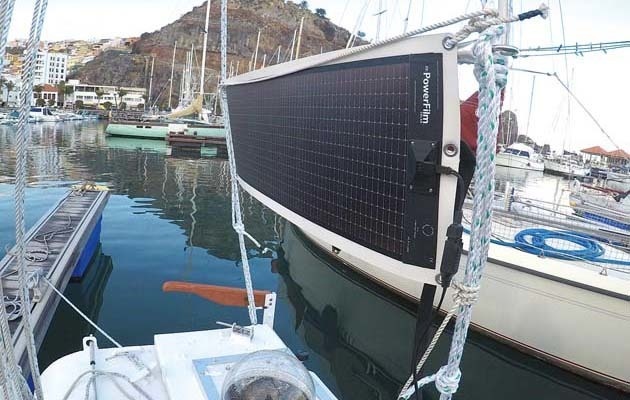
«Inside it becomes more and more cosy. Yes, I say "cozy" because you can't say there's enough room inside. But the more a boat is ready to sail, the more I feel at home inside. Sometimes the comfort is that you can meet your most basic needs».
Loneliness doesn't scare Matt too much.
«I spent weeks all alone in the Guatemalan Heights and lived alone in the woods for years. With so many digital devices, books and daily checks, satellite phone calls, I can hardly really be alone. Meditation is not the last thing in my life, so it is not the biggest problem».
Sync and corrections by n17t01

Matt bought some 106,000 calories of dehydrated food and high-calorie cocktails. Then for another 160,000 calories he bought nuts, fruit, sunflower oil. If the trip drags on for 4 months, his daily diet will be 2,000 kcal.
«My diet consists of dried fruits, protein mix, bars, various soups, stew and pasta, peanut butter, Nutella, etc. In addition, I have two gallons of sunflower oil to add to my diet»," Matt said. - The food on board doesn't need to be cooked, but I have a 12-volt boiling pot to make dinner, tea or coffee if battery power allows. It only takes two minutes to boil the water, so I don't think that's going to be a problem. It all fits in the hold at the keel».
A pass to the sea.
When Wielen first tried to cross the Atlantic in 1993 on Father's Day 5'4", he was wrapped up by the U.S. Coast Guard, so his next (already successful) attempt was in Canada, away from the eyes of American law and order keepers. Focusing on Wielen's experience, Matt decided to cross the Atlantic from east to west:
«Not only because after such a long journey alone, it's better to go home than anywhere else, but also because after walking 4,600 miles of open ocean, I will find myself in the inland waters of the United States. If everything goes as planned, I will go into port, raise my yellow flag and wait for customs. But if it turns out that my presence at the shore is threatening the rest of the water traffic, a small boat will come after me to tow me to the shore. We are doing everything we can to ensure that our actions do not endanger »the lives of others.
The equipment on board that keeps Matt safe includes an AIS and an emergency beacon.
«I have a satellite phone and a team that supports me from shore. They monitor the weather and my progress, send me daily weather reports and know what's happening to me firsthand. And I can also be seen in the AIS»system.
The long-awaited ocean.
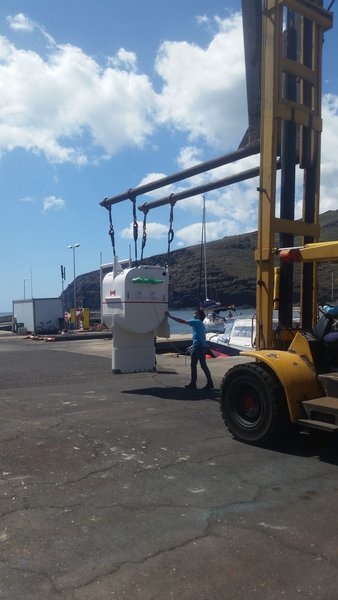
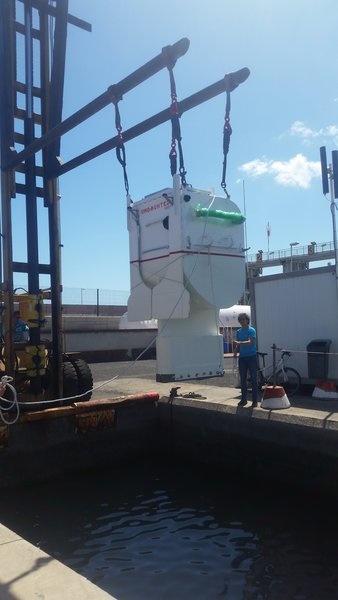
Undaunted touched the ocean in 2017. The point of departure was the island of Homer. Initially, the release was scheduled for March 20, but due to the delay in shipping «Fearless» and waiting for delivery of parts for the buoyancy system, the date slightly shifted.
For Homer with the components, it was quite difficult. With the arrival of «Undaunted», Matt had the opportunity to live for a week on a yacht and eat his entire diet to adapt to the conditions that awaited him in the ocean.
«I'm getting ready to take off. I'm not doing this to get away from everything. Not to be alone and find myself, or to break through the inexorable ocean fighting the elements that could take my life. Not to fight against nature.
I don't want to prove anything. I'm going out to sea to go home.
It's a way to understand what home really is to me».
April 6th, 2017. Matt gave up the mooring at Homer's Marina and went on a transatlantic voyage. But it didn't last long. After a series of setbacks and unforeseen events, Matt had to make a difficult decision and make an emergency call, refusing to continue the journey.
That's what he himself says about the situation on board:
«The part of the buoyancy system that was attached to the rudder feathers started hitting too hard on board in a short wave. Buck jumped so often and so hard that the boat couldn't go forward. Everything went so far that the shackle of the feather to which the tank was attached would break. She had already managed to bend, and one of the fingers of the shackle had dropped almost 2 cm. I untied the tank from the feathers and tied it to the top of the stern so it wouldn't cling to the feathers. All this lasted about an hour».
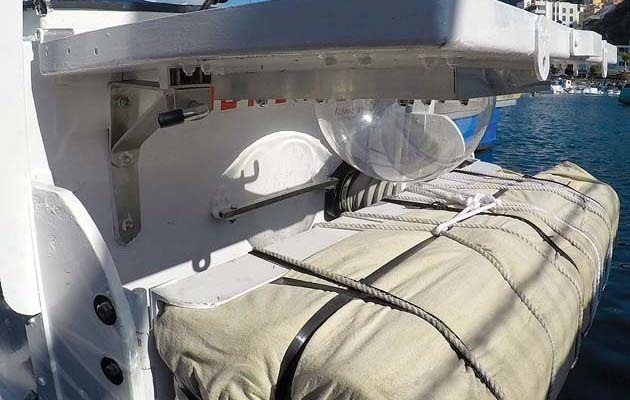
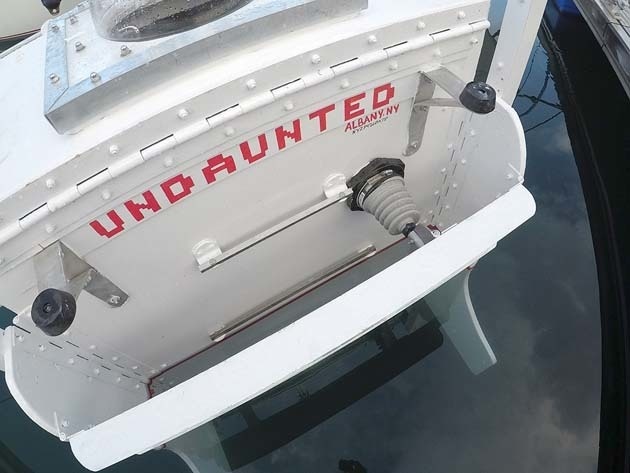
The movement of the waves was absolutely chaotic because the wind between the islands was blowing like a pipe. These were the worst and most unpredictable conditions Matt ever walked in. And when the gusts of wind increased to 45 knots, the traveler looked back at the island and realized that it was not worth continuing with a clearly weak connection at the crossing.
«I talked to Carrie and realized I wouldn't be able to slip through the time window until the hurricane season on the east coast of the United States began. I don't think I'm going this season. I'm gonna pull the boat out, disarm it, and send it home. That's where I'll finish it off. My new goal is to go out in the fall of 2017».
Attempt number two.
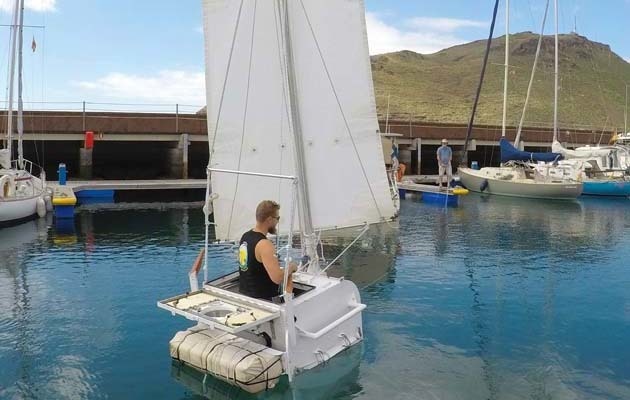
«The fearless» arrived on the island of Homer in December 2017 in anticipation of a new attempt to cross the Atlantic. After working on his mistakes, it was planned to exit «Fearless» from the bay and try out reinforcements for the buoyancy tank. But the local authorities decided differently. Members of the Little Boat Project faced bureaucratic hurdles in obtaining permission from the customs service.
«We have been provided with a list of 15 items to be complied with by all private small boat owners. Of these, we did not have two: an insurance policy for at least 300,000 euros and, more importantly, letters from the U.S. Coast Guard with permission for the trip.
Marina Homer's employees were just as surprised as we were. It was the first time they'd heard of it.
We decided to start from here because there was no problem getting out. Last time there were no problems with customs, but now we had no choice but to move the departure and go to the States».
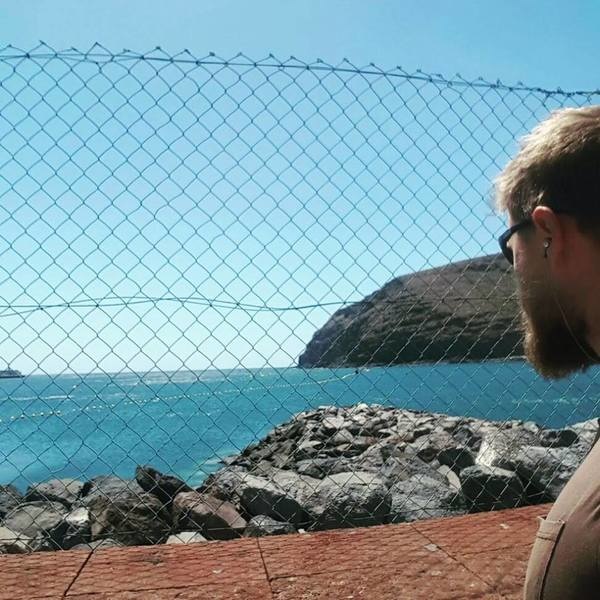
But that didn't stop the Little Boat Project. They intend to go back to the distance again and see it through. The time is coming soon and we hope to see some good news on their website and Facebook page in the near future.


